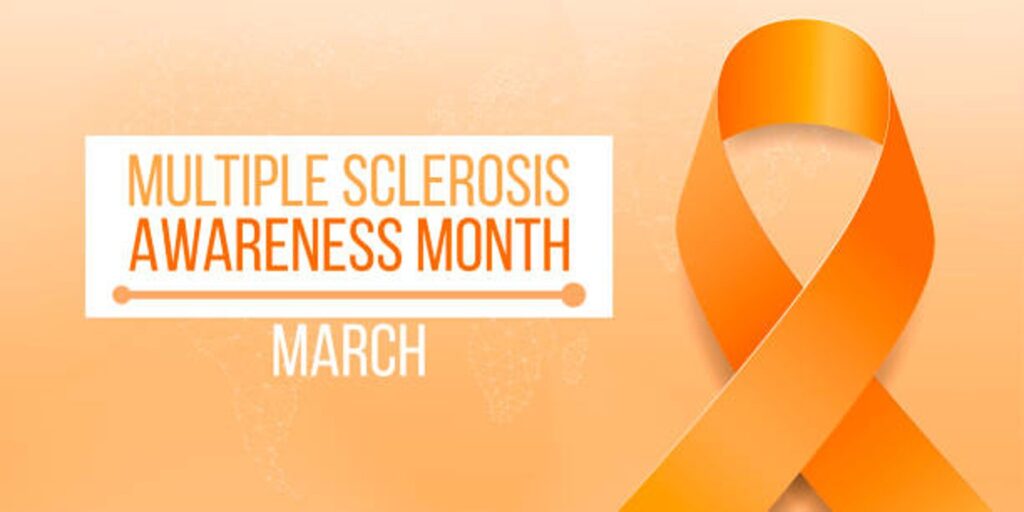March is MS Awareness Month. In this article I share my own MS story, as well as resources and facts – lots of facts! – about MS.
March 1st marked the beginning of Multiple Sclerosis (MS) month. In honor of this month, I am sharing my own story to raise awareness and to attempt to remove a bit of the stigma associated with this disease.
After battling some common symptoms of MS like brain fog, lack of coordination, memory issues, numbness in my arms, legs, hands, and feet for more than two years – a lot longer than that if I’m being honest – I was officially diagnosed via multiple head/brain and full spine MRIs and finally a spinal tap (lumbar puncture) in August of 2022.
What finally prompted the flurry of MRIs and spinal tap (it’s not THAT bad!) was on the evening of July 25, after going out to dinner to celebrate our wedding anniversary, I sat down at home for a few minutes only to discover when I stood up that I had lost all feeling from the waist down. It was terrifying. As I write this, almost eight months later, I still haven’t regained full sensation in my legs or feet which means I never walk barefoot and must be extra careful when shaving my legs (lesson learned).
What brought this on? There are no concrete answers. Stress is most likely the catalyst for my July symptom onset, since I was also in the process of saying farewell to my sister, who passed away in September of 2022.
Is there a cure? Not yet. But there is hope, and a lot of progress in the medical research community. Awareness created by celebrities like Christina Applegate and Selma Blair has helped not only raise awareness but a sense of safety in sharing our diagnosis within my own MS support groups.
I manage my own disease through a combination of diet, exercise – I work out every day no matter how tired or uncoordinated I might feel – and a monthly shot of Kesimpta. Drug therapies aren’t for everyone, but my neurologist and I agreed this was the best course for me, at my stage of disease progression.
I’m not sharing this with you for sympathy. I’m telling you because knowledge is power. Providing a little information on what MS is may give someone the strength or reinforcement knowing that they are not alone, and when to seek a doctor’s consultation and guidance.
WHAT ARE SOME OF THE SYMPTOMS/WARNING SIGNS?
Commonly, multiple sclerosis can cause problems with loss of sensation in arms and legs, the “MS Hug” which feels like someone literally hugging you to death, vision problems including sudden loss of vision in one eye, or, rarely, both eyes; double or blurred vision; severe dizziness; imbalance; numbness; weakness; muscle spasms; tremors; speech problems; depression; and facial pain. These symptoms come and go on their own. Every day is a new adventure!
A common issue with MS is difficulty walking — it is among the most common mobility limitations in MS. Walking difficulties are related to several factors:
· Spasticity: Muscle tightness.
· Balance: Swaying and “drunken” type of gait known as ataxia.
· Sensory deficit: Numbness in the feet preventing or limiting what is felt on the feet.
· Fatigue and Weakness
Note for all the “dress code police” out there – yes, I wear tennis shoes pretty much 98% of the time.
SO, WHAT THE HECK IS MS?
MS is an autoimmune disease within the body’s immune system that impacts the brain and spinal cord, which make up the central nervous system (CNS). The central nervous system connects to every aspect of our overall health.
It is responsible for basic functions such as: walking, speaking, swallowing, breathing, and learning. It is also in charge of movements, such as balance and coordination as well as
senses, including how the brain interprets what is seen, heard, tastes, touches, and feels.
In MS, the immune system attacks the myelin sheath, the outer protective layer of the CNS which then exposes and damages the nerves.
To better understand this, think of a phone charger. If the charger plastic wears or becomes damaged, you may have to move the charging cord around until it gets a signal. Once you get the charger to work, you hope that there is no movement to the cord, or the signal will be interrupted.
In MS, the myelin (the plastic around the wires) is attacked, nerves (wires) inside the sheath become damaged. This damage (sclerosis/scars) interrupts the communication within your body. Sometimes, the body will carry the signal as it should, sometimes, it doesn’t (like when moving the phone charger).
There are no two people with the same symptoms. There are some people who will have an exacerbation (attack) and then never have an attack again, or they might go years before they have another attack. There are others who are symptomatic, but the symptoms change from person to person, and over time, depending on the areas that are scarred.
WHERE DO I GO FOR MORE INFORMATION?
The National Multiple Sclerosis Society’s website is, hands-down, the best source around: https://www.nationalmssociety.org/
#31DaysOfMS
#msawareness
#multiplesclerosisawareness







